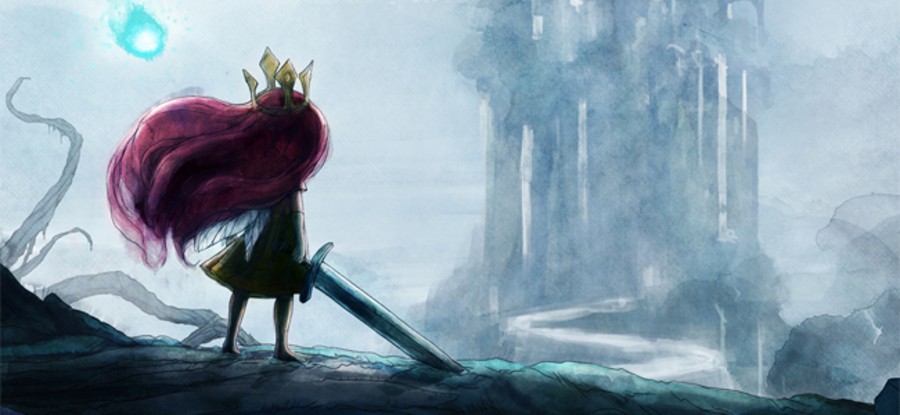
The second UbiArt-powered game to be unveiled at Ubisoft’s Digital Days 2013 event, Child of Light – which is launching on both the PlayStation 3 and PlayStation 4 – was pitched to us as “a JRPG for those that don’t have the time to invest a hundred hours into a game”. While this quote may trouble some hardcore JRPG fans, know that the title is shaping up to be something very special.
In a world and story that’s being kept tightly under wraps, you play as a little princess called Aurora and are accompanied by Igniculus, a firefly. In our hands-on demo, the duo inhabited the ‘dream world’. When we pressed for details as to just what that meant, it was revealed that the game takes place between Aurora’s reality and her dreams, although the details pertaining to the relevance of either were not given.
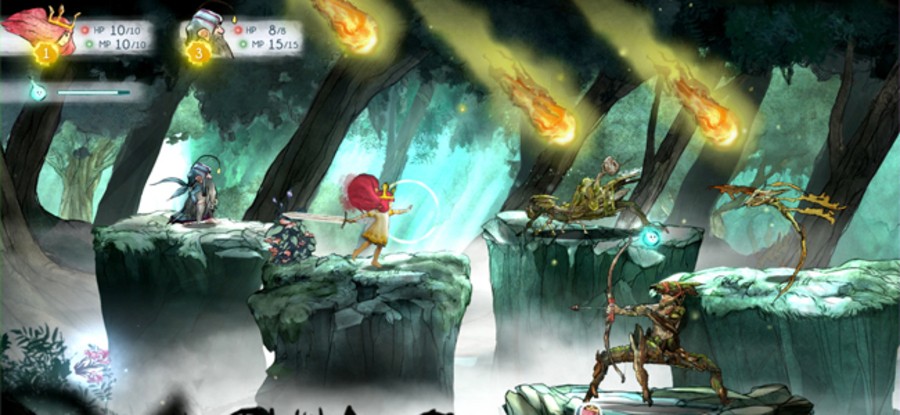
When we first began our session, which was set near to the start of the game, we were witness to Aurora and Igniculus arguing. Apparently, to begin with, the twosome don’t get along particularly well. Aurora seemed to believe that Igniculus must accompany her on her travels, while the firefly rightly pointed out that they don't actually know one another. However, after the girl’s persistent requests, Igniculus eventually accepted his duty to join her.
As with other titles running on the UbiArt engine, Child of Light is a 2D side-scroller. Aurora has the ability to fly around the screen and interact with things in the environment, while Igniculus floats after her. Harnessing the power of next generation consoles, the title is hands down one of the most strikingly beautiful games that we’ve ever seen, adopting an otherworldly watercolour art style. The music, too, is entirely appropriate for its setting, with tinkling pieces that complement the gameplay and story perfectly.
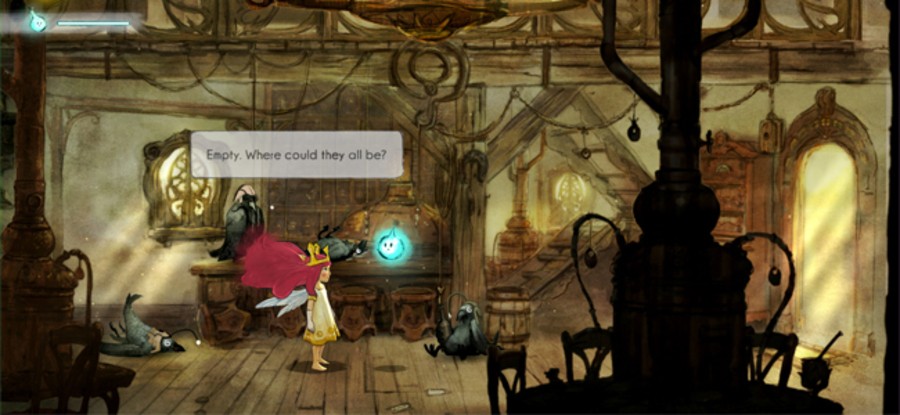
Designed to look and sound as it does, one might be forgiven for assuming that it’s aimed at kids, but the game has some rather dark undertones that will make it inappropriate for those below a certain age. While you’ll never hear a character swearing, for example, the short portion of narrative that we experienced was similar to the unedited Brothers Grimm stories, as the village that we happened upon had been cursed so that all of the locals assumed the role of crows.
Child of Light is one of the most beautiful games we’ve ever seen
After asking around a little, with Igniculus mocking us for trying, we came across a peculiar bearded gnome-like creature who outlined that the reason for the village’s fate may lie in the local well. So, approaching the well, we hopped in. We were then loaded into a vast underground cavern with tunnels and caves branching off in different directions.
We’d noticed that when we sat down at the demo unit that there was a second controller by the system, but until now, no one had been using it. Scooping up the controller, a fellow journalist was able to take control of Igniculus. Flying around the screen, the firefly can traverse certain obstacles that Aurora cannot, unlocking hidden treasure and healing orbs. That’s not to say that Igniculus does nothing without being told to – he’ll still follow Aurora around on his own as well as cast light – but it’s nice that some thought was invested into making him a little more interactive.
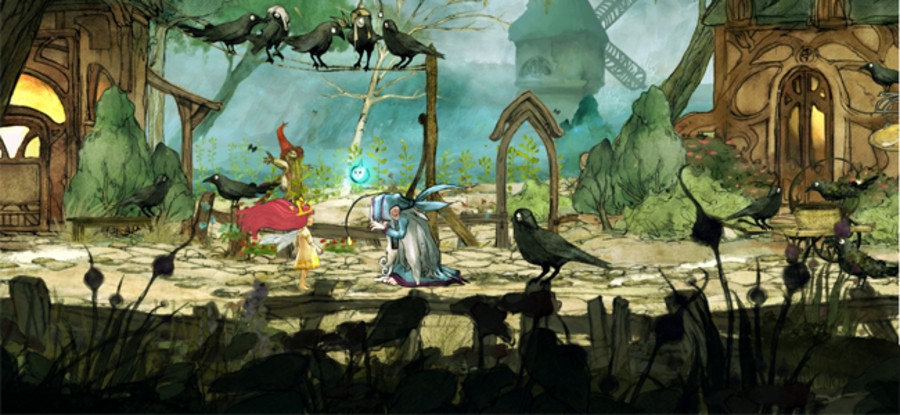
As we made our way around the subterranean levels, we noticed a couple of things that piqued our interest. Firstly, all enemies appear in their physical form, standing to attention in front of something valuable or patrolling a certain area. This means that you’ll know what you’re getting into as you traverse the environment instead of being plagued by random battles with invisible foes, which puts a number of people off JRPGs. Also, you’ll be able to leave messages for your friends – which we assume means the people on your friends list – giving them helpful hints and tips, just like in Dark Souls.
Upon entering our first battle, we found numerous similarities to recent JRPG battle systems such as Ni No Kuni: Wrath of the White Witch. As with most turn-based battle systems, your party resides on the left, while enemies appear on the right. At the bottom of the screen is a gauge that details whose turn it is and when, with a ‘cast’ area at the end. Each of the participant’s images are positioned on the gauge, and upon reaching the start of the ‘cast' area, you’re able to decide upon your attack which is launched when the corresponding fighter's image reaches the end of the bar.
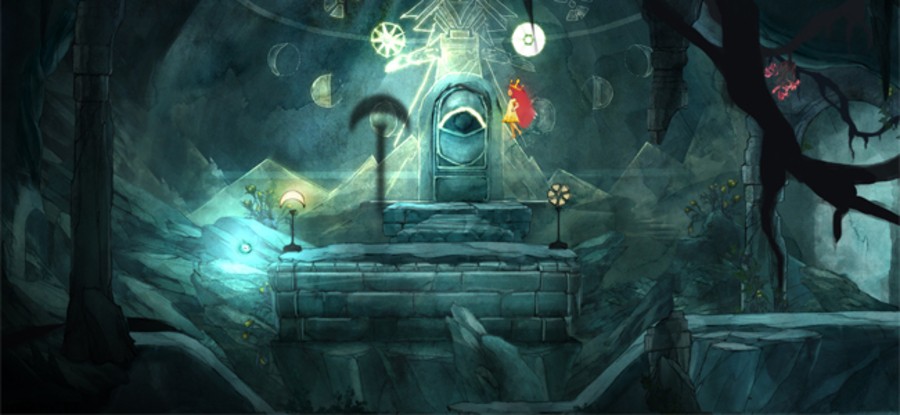
However, should you reach the end of the 'cast' area and attack while an enemy’s also moving towards the end of that area, the individual receiving the attack will be interrupted and miss their go. While this may sound cheap, once someone’s chosen their attack, they can travel towards the end of the cast area at varying speeds, so you may find yourself bunny hopping someone else, performing your attack, and interrupting them so that they must start from the bottom of the gauge again.
In terms of the offensive abilities that are on offer, all characters are equipped with some sort of weapon and each focuses on a different area of magic. Aurora, for example, uses offensive fire and ice spells, whereas the aforementioned gnome character employs healing magic. The interface for selecting such things is clear and easy to use, and, once you’ve won a battle, you’ll be awarded with XP. Should you go up a level, not only will your HP and MP increase, but you’ll be given a skill point to spend as well. These can be spent on perks that are specific to each character, and the branching nature means that you can build party members to your requirements. Perks such as increased fire damage, enhanced healing, and more impactful spells are all available from the off.
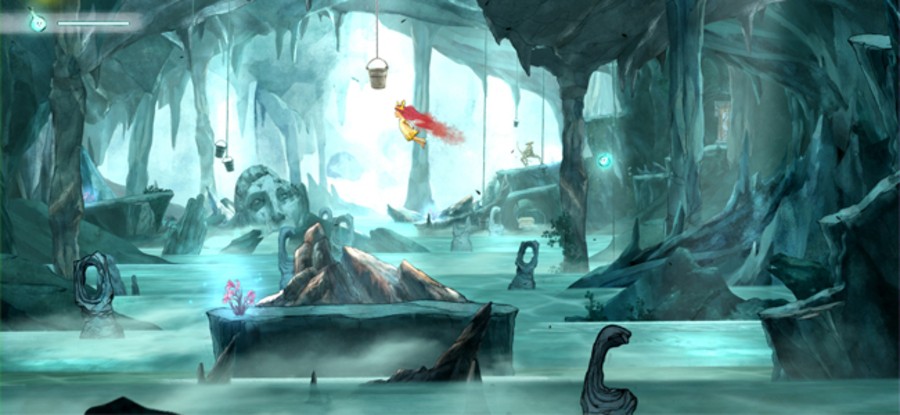
While Igniculus doesn’t fight in battles, he’s far from useless. When controlled by a second player, he can fly freely around the screen, helping the party. Within the battle screen’s environment there’ll be plants containing orbs, and should he fly into them, they’ll restore HP and MP for the party. By holding down the X button, he can also blind enemies, who will subsequently recoil, stunned, opening an opportunity for more powerful attacks. Using this same ability, he can slowly restore a small amount of a party member’s HP, too – although this removes essence from a bar, and once it’s gone, you must wait for it to restore.
Child of Light is one of those rare games that we believe can appeal to core and casual gamers alike. It manages to remain compelling without excluding anyone, and the simplified action is much more engaging than it may initially seem. With an interesting premise, solid gameplay mechanics, stunning art direction, and captivating music, we’ll be keeping a very close eye on this one.
Are you looking forward to Child of Light? Are you worried that the gameplay may end up a little too simplistic? What are your thoughts on the art direction? Let us know in the comments section below.





Comments 10
A JRPG for people that don't have 100 hours to spend on a game could not describe my needs better.
Great preview, Ben. Yeah, the concept appeals to me, too. It almost reminds of Costume Quest conceptually, which was also a very simple RPG that could be completed in around 5 hours. I really enjoyed that.
Even with the more in depth information here it still sounds a lot like Puppeteer, which is good, only Puppeteer just came out.
Some examples -
2D side-scroller. Aurora has the ability to fly around the screen and interact with things in the environment, while Igniculus floats after her.
When controlled by a second player, he can fly freely around the screen, helping the party.
but the game has some rather dark undertones that will make it inappropriate for those below a certain age. (my wife won't let my 8 yr. old son play Puppeteer, though I think he'ld excel at it, platforming is his thing)
Just surprised this gets compared to Ni No Kuni, which isn't really turn based, it's more action, and not Puppeteer.
Looking forward to it, but not impressed?
I am glad it's PS3 though
I'll gladly try anything from the engine of Rayman which is very beautiful.
Ill buy it
@get2sammyb Costume Quest is easily one of my top 10 games I've played on PS3 for that reason. Off topic but I'd love to see Double Fine revisit that world with a little more budget to expand it a bit and include voice acting and cutscenes because I just absolutely love that sort of story and gameplay.
I just wish that this game was being released on PS Vita. It looks so amazing!
@rjejr unfortunately I'm yet to play The Puppeteer so I couldn't make the comparison. I was mainly comparing the simplified RPG components with those of Ni Na Noo Nah
Looks interesting. Always looking for something that is actually interesting to play with my 9 yr old daughter. Not sure if this is still slightly too mature though. Would need to see more of the combat.
Look interesting, but not sure about the Gameplay
Show Comments
Leave A Comment
Hold on there, you need to login to post a comment...